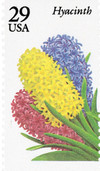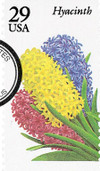
1993 29c Garden Flowers: Hyacinth
# 2760 - 1993 29c Garden Flowers: Hyacinth
$0.35 - $3.20
U.S. #2760
1993 29¢ Hyacinth
Garden Flowers
1993 29¢ Hyacinth
Garden Flowers
Issue Date: May 15, 1993
City: Spokane, WA
Quantity: 199,784,000
City: Spokane, WA
Quantity: 199,784,000
Printed By: Bureau of Engraving and Printing
Printing Method: Lithographed, engraved
Perforations: 11 vertically
Color: Multicolored
This stamp belongs to the 1993 Garden Flowers set. These colorful flowers blossomed into a booklet of stamps in mid-June. Featuring one continuous se-tenant design, the stamps pictured five favorite garden flowers, including the lilac, daffodil, tulip, iris, and hyacinth.
U.S. #2760
1993 29¢ Hyacinth
Garden Flowers
1993 29¢ Hyacinth
Garden Flowers
Issue Date: May 15, 1993
City: Spokane, WA
Quantity: 199,784,000
City: Spokane, WA
Quantity: 199,784,000
Printed By: Bureau of Engraving and Printing
Printing Method: Lithographed, engraved
Perforations: 11 vertically
Color: Multicolored
This stamp belongs to the 1993 Garden Flowers set. These colorful flowers blossomed into a booklet of stamps in mid-June. Featuring one continuous se-tenant design, the stamps pictured five favorite garden flowers, including the lilac, daffodil, tulip, iris, and hyacinth.














